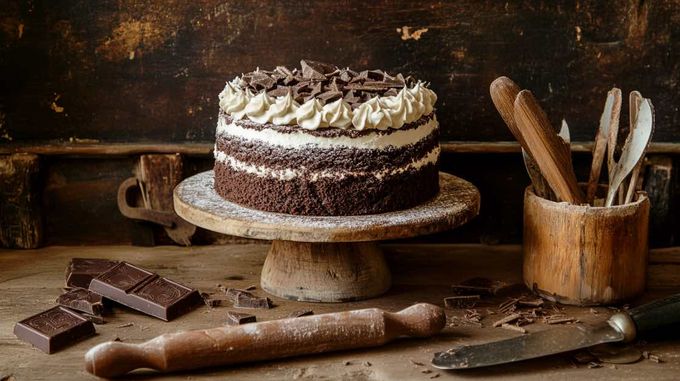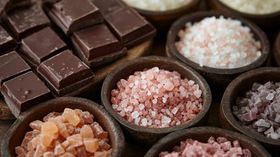How to Use Bean-to-Bar Chocolate in Pastry & Baking Recipes
From bean to baked good: The ultimate guide to using high-quality chocolate in your recipes
Published January 13, 2025

For pastry chefs and home bakers seeking to elevate their craft, bean-to-bar chocolate offers an unparalleled opportunity to create desserts with exceptional depth, complexity, and character.
Unlike mass-produced alternatives, these artisanal chocolates capture the unique terroir of their source regions, transforming ordinary recipes into extraordinary culinary experiences.
Let's explore how to make the most of bean-to-bar chocolate in your kitchen!
» Elevate your baking with the exquisite flavors of bean-to-bar chocolate
Understanding Bean-to-Bar In Baking
When working with bean-to-bar chocolate, it's essential to understand its unique properties. They often have different ratios of cacao mass to cacao butter compared with commercial versions, even at the same percentage.
For instance, a 70% bean-to-bar chocolate might contain 60% cacao mass and varying amounts of cacao butter, which can significantly impact your recipe's texture and flavor profile.
The natural cacao butter content varies between different bean origins, with some beans naturally containing more fat than others. This variation affects the chocolate's performance in various applications, particularly in creating bonbon shells or other molded items.
Here are some key characteristics to consider when working with bean-to-bar chocolate:
- Bean-to-bar chocolates typically have a thicker consistency when melted than commercial chocolates, which often contain additives like lecithin to increase fluidity. This thickness isn't a sign of improper melting—it's a natural characteristic of the chocolate.
- The fluidity depends heavily on the specific bean variety used, with some beans naturally producing more fluid chocolate due to higher cacao butter content.
- These chocolates tend to be less sweet than commercial alternatives, so adjusting the sugar content in your recipes to achieve your desired taste level might be necessary.
» Learn about the history of how traditional chocolate is made
Why Choose Bean-to-Bar Chocolate?
The magic of bean-to-bar chocolate lies in its meticulous production process. Each maker carefully selects raw cacao beans, roasts them to develop specific flavor profiles, and controls every step to the final tempered bar. This attention to detail creates chocolate with a pronounced personality.
These distinct characteristics manifest in practical advantages for bakers:
- Superior melting properties: Bean-to-bar chocolate typically contains higher percentages of cocoa butter and fewer additives, resulting in superior melting properties that create silkier ganaches and more luxurious mouthfeel in finished desserts.
- Complex flavor development: The careful fermentation and roasting processes develop complex flavor compounds that remain stable during baking, allowing subtle notes like jasmine, cherry, or caramel to shine through in the finished product.
- Purer flavor transmission: The absence of emulsifiers and artificial stabilizers means purer flavor transmission and better integration with other high-quality ingredients, particularly in delicate applications like mousses and soufflés.
- Health benefits: Dark bean-to-bar chocolate with high cocoa content contains antioxidants (like flavonols) linked to improved blood flow and heart health. It often contains fewer additives (no lecithin!) and is usually gluten-free and vegan.
- Versatility: The range of flavor profiles offered by different bean-to-bar origins provides incredible versatility for bakers. You can experiment with diverse flavor combinations and create unique and exciting dessert experiences.
- Quality control: By sourcing directly from the bean, bean-to-bar makers have greater control over the production process, ensuring consistent quality and minimizing the risk of undesirable flavors or impurities.
» Discover every step in the single-origin, bean to bar chocolate process
How to bake with bean-to-bar chocolate
Bean-to-bar chocolate truly shines when its unique flavor profile is the star. Here are some of the best applications:
- Mousses: Water-based mousses are ideal. By minimizing the influence of dairy, you allow the chocolate's subtle nuances to shine through. Experiment with different flavor pairings like rosewater, orange blossom water, or even a touch of chili for an unexpected twist.
- Brownies: Bean-to-bar chocolate's higher cacao butter content creates an unparalleled rich, fudgy texture. Simple recipes using only chocolate and dates, or perhaps a touch of sea salt, allow the chocolate's complex flavor notes to take center stage.
- Ganaches and Sauces: These applications help showcase the chocolate's unique terroir. Keep the recipe simple—perhaps just cream and chocolate—to truly appreciate the origin and processing methods reflected in the chocolate's flavor. Drizzle over fresh berries or use as a filling for cakes.
- Bonbons and Molded Chocolates: This is where you can highlight the chocolate's complexity. Experiment with different tempering methods to achieve varying textures and snap. Consider incorporating flavor pairings like coffee, spices, or dried fruits to complement the chocolate's unique character.
Beyond traditional baking
Bean-to-bar chocolate isn't limited to sweet applications. Consider these innovative uses:
- Create savory sauces inspired by Mexican mole, incorporating chilies, spices, and sesame for a complex flavor profile.
- Develop unique vinaigrettes for salads by incorporating small amounts of melted chocolate.
- Experiment with chocolate-based sauces for meat dishes, particularly game or beef, where the chocolate's complex flavors can enhance the meat's natural richness.
Technical handling and tempering
Working with premium bean-to-bar chocolate requires understanding its unique properties and adjusting techniques accordingly. The higher cocoa butter content that makes these chocolates unique also means they respond differently to temperature and handling than commercial alternatives.
Working with bean-to-bar chocolate requires attention to specific technical details:
- When melting, bean-to-bar chocolate often appears thicker than commercial alternatives, even at proper temperatures. This isn't a flaw—it's due to the absence of additives like lecithin that increase fluidity.
- For tempering dark chocolate, follow this general curve: melt to 45-50°C (113-122°F), cool to 27-28°C (80-82°F), then reheat to 31-32°C (88-90°F). However, specific chocolates may require slight adjustments to these temperatures, so experiment with each new batch.
- For melting chocolate, using a microwave with careful control offers excellent results. If you use a bain-marie, you should exercise extra caution to prevent burning, as bean-to-bar chocolate can be more sensitive to overheating.
- When the chocolate needs more fluidity for applications like bonbon shells, consider adding melted cacao butter rather than relying on temperature adjustments.
Tip: While high-temperature baking can slightly degrade cacao's beneficial compounds, prioritize lower-temperature methods or no-bake options whenever possible to preserve their nutritional value
» Learn why dates are the superior sweetener for chocolate
Alternative dietary considerations
Bean-to-bar chocolate's purer composition makes it especially valuable in alternative baking scenarios:
For Vegan Baking: Bean-to-bar dark chocolate is naturally dairy-free and often soy-free, making it a perfect fit for vegan baking. Its high-quality cocoa butter can help create a rich, smooth texture, often eliminating the need for additional vegan fats or emulsifiers.
For Gluten-Free Baking: The high-quality fat content in bean-to-bar chocolate contributes to excellent emulsification, helping maintain moisture and create a better crumb structure in gluten-free baked goods. These flours can sometimes result in dry or crumbly textures, so to ensure optimal results, monitor the liquid-to-flour ratio in your batter.
For Health-Conscious Baking: The intense flavor of bean-to-bar chocolate allows you to use less chocolate overall, reducing calories while achieving rich, satisfying results.
» Learn more about the health benefits of cacao
Showcase recipes featuring KAICAO chocolate
At KAICAO, we stand out in the bean-to-bar chocolate world for our exceptional quality and commitment to craftsmanship. Our chocolate is crafted from carefully selected beans with optimal professional and home baking properties, ensuring consistent results and outstanding flavor profiles.
Simple KAICAO Uganda chocolate mousse
This innovative dessert proves that sometimes less is more. KAICAO's Uganda chocolate is particularly suited for this recipe due to its natural fruity notes and perfect cacao butter content balance, creating an impossibly smooth texture.
Prep Time: 10 minutes Chill Time: 24 hours Total Time: 24 hours 10 minutes
Ingredients:
- 250g 70% KAICAO Uganda chocolate
- 250g oat milk (or water)
- Optional Uganda cacao nibs for garnish
Instructions:
- Begin by heating your oat milk until it's hot but not boiling. Meanwhile, chop your chocolate into small, uniform pieces to ensure smooth melting.
- Blend both ingredients until smooth and homogeneous. The mixture should be glossy and well-emulsified.
- Pour into serving bowls or a large container and refrigerate for 24 hours. This resting time allows the mousse to develop its perfect texture.
- Before serving, garnish with cacao nibs for an extra crunch and intensity of flavor.
» Enhance the fudgy flavor with KAICAO's 70% Uganda chocolate
Sophisticated Tanzania olive oil bonbons
KAICAO's Tanzania-origin chocolate is renowned for its distinctive floral notes, making it the perfect partner for this elegant recipe. The high-quality processing ensures that these delicate flavor notes remain stable throughout the tempering process.
Prep Time: 15 minutes Set Time: 2 hours Total Time: 2 hours 15 minutes
Ingredients:
- 200g Tanzania 75% chocolate
- 300g extra virgin olive oil
- Pinch of salt
Instructions:
- Start by carefully melting your Tanzania chocolate using a double boiler or microwave on low power. The key is maintaining a temperature that preserves the chocolate's delicate floral notes.
- Once melted, add olive oil gradually while blending with a handheld blender. This creates a stable emulsion that captures the best qualities of both ingredients. Add a pinch of salt to enhance the flavors.
- This versatile ganache can be used as a bonbon filling, as the base for tartelettes, or served on its own as a decadent dessert component. If making bonbons, allow the ganache to set fully before enrobing.
» Try the sweetness and a hint of tartness of KAICAO's Tanzania chocolate
Ultimate vegan KAICAO Uganda chocolate brownies
KAICAO's Uganda chocolate is particularly well-suited for these brownies due to its natural banana and fruit notes. These notes complement the dates perfectly and create an incredibly rich, complex flavor profile.
Prep Time: 15 minutes Cook Time: 25 minutes Total Time: 40 minutes (plus cooling)
Ingredients:
- 200g 70% KAICAO Uganda chocolate
- 125ml sunflower oil
- 8 Medjool dates
- 80ml oat milk
- 200g almond flour
- 1/2 teaspoon baking powder
- Pinch of salt
- 50g chopped KAICAO Uganda 70% chocolate for mixing in
Instructions:
- Preheat your oven to 175°C and line an 8x8-inch baking pan with parchment paper.
- Break your Uganda chocolate into small pieces and melt it gently with the sunflower oil using a double boiler or microwave in 20-second bursts.
- Blend your dates with the oat milk until smooth while the chocolate cools slightly.
- In a separate bowl, combine your almond flour, baking powder, and salt. Fold these dry ingredients into your chocolate mixture until you have a smooth batter.
- Stir in the chopped chocolate pieces for extra texture and intensity.
- Pour into your prepared pan and bake for 20–25 minutes.
- Let them cool completely before cutting—this will reward you with the perfect fudgy texture.
The art of baking with bean-to-bar chocolate
Bean-to-bar chocolate elevates baking and pastry-making to a new level of artistry. Its complex flavor profiles, ranging from fruity and floral to earthy and spicy, can transform ordinary desserts into extraordinary creations.
When incorporating bean-to-bar chocolate into your recipes, start with small batches to understand how its unique characteristics interact with other ingredients. Document your findings, noting how different origins affect your creations' texture, aroma, and overall flavor.
Don't be afraid to experiment and adjust traditional recipes to fully embrace the exceptional quality and nuanced flavors that bean-to-bar chocolate brings.
» Indulge your passion for baking with the finest bean-to-bar chocolate from KAICAO
Indulge in the finest single-origin cacao
Disclaimer: The chocolate information provided by KAICAO is intended for educational purposes related to chocolate products. We encourage you to embrace the chocolate experience, savor each moment, and explore the world of chocolate with passion.


